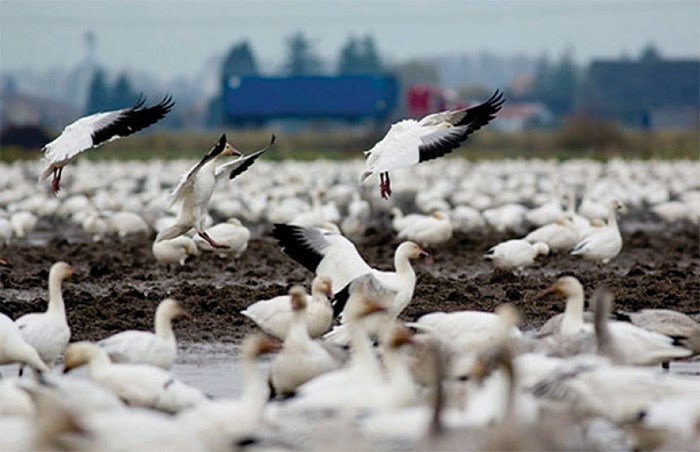 It appears the local snow geese population will continue to climb past the current 108,000 mark. File photo
It appears the local snow geese population will continue to climb past the current 108,000 mark. File photo
It’s going to be bad news if their numbers keep growing.
A huge population of snow geese is again making its presence known in Delta, as birds arrive annually from Wrangel Island in Russia. Roughly half the migrating birds travel the Pacific Flyway to central California with the remainder wintering in B.C. and Washington.
A lesser snow goose management plan a few years ago recommended a population of no higher than 50,000 to 70,000 in this area, but initial estimates have this year’s population at over 108,000, matching last year’s total. Problem is, it appears the numbers will continue to climb.
That means trouble since tidal marshes, including Westham Island, are seeing overgrazing, while farms are also feeling the impact. Most geese and other water fowl will graze on grasses above the soils, but snow geese will dig down and eat the entire plant, roots and all, to cause substantial damage.
In Richmond the problem is even more pronounced as geese are being forced away from the marsh near the �鶹��ýӳ��Airport, prompting them to occupy city parks and playgrounds.
Sean Boyd, a federal bird biologist with Environment and Climate Change Canada, has been studying snow geese populations since the 1980s, when the Fraser-Skagit population was around 50,000. Last year’s number was the highest ever recorded, he said.
“I’ve heard reports from a Russian biologist on Wrangel Island that weather conditions were pretty good and quite a few young came off the colony, so I expect at least 108,000 to 112,000, but probably more. So we could have another bumper year.”
A variety of factors are behind the robust population including warmer weather at Wrangel Island, bird sanctuaries and farms along their flight paths as well as a lack of hunting.
Boyd noted that there was a balance as far as the marshes regrown to what is being consumed by the geese in the 1990s, but after their number swelled above 60,000 there’s been more pressure on the estuary. It’s something that can been seen at Wetsham Island where a very large mudflat has grown in place of the important marsh, he warned.
“You can say they’re negatively affecting their own food source in the marshes,” he said.
Boyd noted for some reason farms in Delta haven’t been as ravaged as much as one would expect. He suspects that’s because a healthy eagle population is keeping geese away. However, in the next few years farms could have a big problem if the geese lose their food source, he explained.
Delta councillor and MLA Ian Paton, an East Ladner hay farmer, said he’s noticed a lot of waterfowl including lesser snow geese on his farm and other farmers have been saying the same thing regarding their land.
“People don’t understand that geese can come in and really clean out your hay crop, so in the spring when grass starts growing you will say, ‘My goodness, my volume is down 40 per cent because of the damage that was done by geese,’” he said. “We do have a provincial program we’re enrolled in where we do get some compensation from damage from geese and ducks and swans but it never seems to amount to the cost of reseeding.”
Drew Bondar, program manager for the Delta Farmland and Wildlife Trust, said his group doesn’t have numbers as far as how much of the winter cover crops they planted have been eaten up by the waterfowl.
A DFWT report notes it’s estimated that by March every winter, 70 per cent of all winter cover crops fields planted for waterfowl in Delta show evidence of grazing and 50 percent are intensely grazed.


